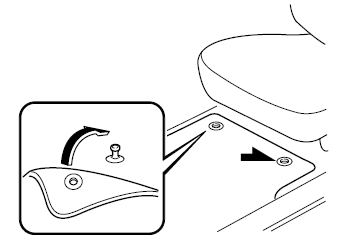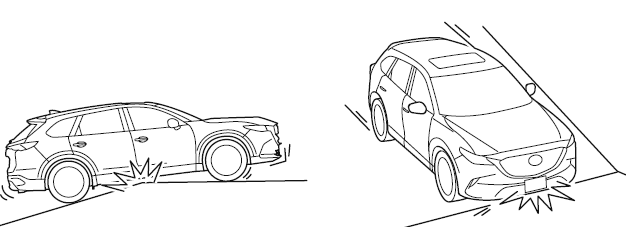Mazda CX-9 Owners Manual: Driving Tips
Break-In Period No special break-in is necessary, but a few precautions in the first 1,000 km (600 miles) may add to the performance, economy, and life of the vehicle.
Saving Fuel and Protection of the Environment How you operate your Mazda determines how far it will travel on a tank of fuel. Use these suggestions to help save fuel and reduce CO2.
WARNING Never stop the engine when going down a hill: Stopping the engine when going down a hill is dangerous. This causes the loss of power steering and power brake control, and may cause damage to the drivetrain. Any loss of steering or braking control could cause an accident. Hazardous Driving WARNING Be extremely careful if it is necessary to downshift on slippery surfaces: Downshifting into lower gear while driving on slippery surfaces is dangerous. The sudden change in tire speed could cause the tires to skid. This could lead to loss of vehicle control and an accident. Avoid sharp turns, excessive speed and abrupt maneuvers when driving this vehicle: Sharp turns, excessive speed and abrupt maneuvering of this vehicle are dangerous as it could result in the increased risk of loss of vehicle control, vehicle roll-over, personal injury or death. This vehicle has a higher center of gravity. Vehicles with a higher center of gravity such as utility vehicles handle differently than vehicles with a lower center of gravity. Utility vehicles are not designed for cornering at high speeds any more than low profile sports cars are designed to perform satisfactorily under off-road conditions. In addition, utility vehicles have a significantly higher rollover rate than other types of vehicles. In a rollover crash, an unbelted person is significantly more likely to die than a person wearing a seat belt. When driving on ice or in water, snow, mud, sand, or similar hazards:
NOTE Use snow chains only on the front wheels. Floor Mat We recommend the use of Genuine Mazda floor mats. WARNING Make sure the floor mats are hooked on the retention pins to prevent them from bunching up under the foot pedals: Using a floor mat that is not secured is dangerous as it will interfere with the accelerator and brake pedal operation, which could result in an accident. Do not install two floor mats, one on top of the other, on the driver's side: Installing two floor mats, one on top of the other, on the driver's side is dangerous as the retention pins can only keep one floor mat from sliding forward. Loose floor mat(s) will interfere with the foot pedals and could result in an accident. If using an all-weather mat for winter use always remove the original floor mat.
When setting a floor mat, position the floor mat so that its grommets are inserted over the pointed end of the retention posts. Rocking the Vehicle WARNING Do not spin the wheels at more than 56 km/h (35 mph), and do not allow anyone to stand behind a wheel when pushing the vehicle: When the vehicle is stuck, spinning the wheels at high speed is dangerous. The spinning tire could overheat and explode. This could cause serious injuries. CAUTION Too much rocking may cause engine overheating, transaxle failure, and tire damage. If you must rock the vehicle to free it from snow, sand or mud, depress the accelerator slightly and slowly move the selector lever from D to R position. Winter Driving Carry emergency gear, including tire chains, window scraper, flares, a small shovel, jumper cables, and a small bag of sand or salt. Ask an Authorized Mazda Dealer to check the following:
NOTE
Snow Tires Use snow tires on all four wheels Do not go faster than 120 km/h (75 mph) while driving with snow tires. Inflate snow tires 30 kPa (0.3 kgf/cm2, 4.3 psi) more than recommended on the tire pressure label (driver's door frame), but never more than the maximum cold-tire pressure shown on the tires. The vehicle is originally equipped with all season radials designed to be used all year around. In some extreme climates you may find it necessary to replace them with snow tires during the winter months to further improve traction on snow and ice covered roads. WARNING Use only the same size and type tires (snow, radial, or non-radial) on all four wheels: Using tires different in size or type is dangerous. Your vehicle's handling could be greatly affected and result in an accident. CAUTION Check local regulations before using studded tires. NOTE If your vehicle is equipped with the tire pressure monitoring system, the system may not function correctly when using tires with steel wire reinforcement in the sidewalls. Tire Chains Check local regulations before using tire chains. CAUTION
NOTE
Install the chains on the front tires only. Do not use chains on the rear tires. Please consult an Authorized Mazda Dealer. Installing the chains 1. Secure the chains on the front tires as tightly as possible. Always follow the chain manufacturer's instructions. 2. Retighten the chains after driving 1/2―1 km (1/4―1/2 mile). Driving In Flooded Area WARNING Dry off brakes that have become wet by driving slowly, releasing the accelerator pedal and lightly applying the brakes several times until the brake performance returns to normal: Driving with wet brakes is dangerous. Increased stopping distance or the vehicle pulling to one side when braking could result in a serious accident. Light braking will indicate whether the brakes have been affected. CAUTION Do not drive the vehicle on flooded roads as it could cause short circuiting of electrical/electronic parts, or engine damage or stalling from water absorption. If the vehicle has been immersed in water, consult an Authorized Mazda Dealer. Overloading WARNING Be careful not to overload your vehicle: The gross axle weight rating (GAWR) and the gross vehicle weight rating (GVWR) of the vehicle are on the Motor Vehicle Safety Standard Label on the driver's door frame. Exceeding these ratings can cause an accident or vehicle damage. You can estimate the weight of the load by weighing the items (or people) before putting them in the vehicle. Driving on Uneven Road Your vehicle's suspension and underbody can be damaged if driven on rough/uneven roads or over speed bumps at excessive speeds. Use care and reduce speed when traveling on rough/uneven roads or over speed bumps. Use care not to damage the vehicle's underbody, bumpers or muffler(s) when driving under the following conditions:
This vehicle is equipped with low profile tires allowing class-leading performance and handling. As a result, the sidewall of the tires are very thin and the tires and wheels can be damaged if driven through potholes or on rough/uneven roads at excessive speeds. Use care and reduce speed when traveling on rough/uneven roads or through potholes. Turbocharger Information CAUTION
The turbocharger greatly enhances engine power. Its advanced design provides improved operation and requires minimum maintenance. To get the most from it, observe the following. 1. Change engine oil and filter according to Scheduled Maintenance. 2. Use only recommended engine oil. Extra additives are NOT recommended. |
See More:
Mazda CX-9 Owners Manual > i-ACTIVSENSE: Distance Recognition Support
System (DRSS)
The DRSS measures the distance between your vehicle and a vehicle ahead using a radar sensor (front) while the vehicle speed is about 30 km/h (19 mph) or faster, and if your vehicle approaches a vehicle ahead more closely than what is appropriate for maintaining distance between the vehicles accordi ...




